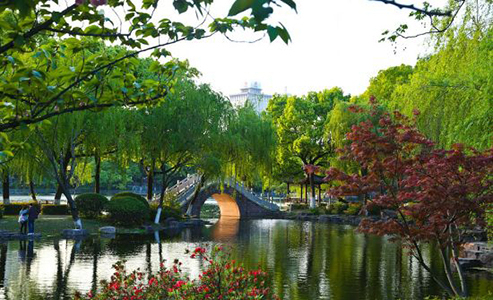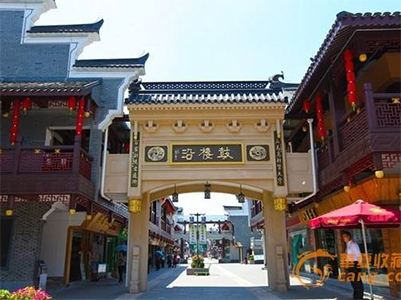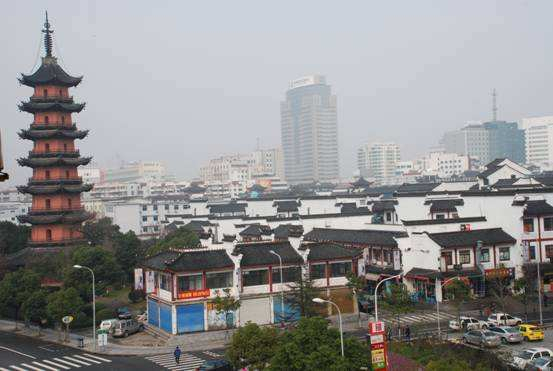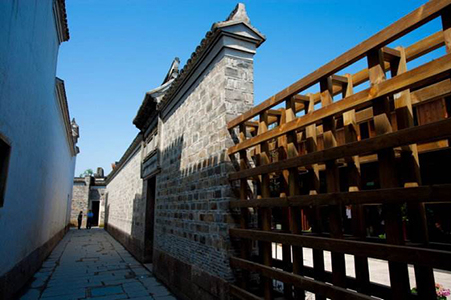Historical block
Moon Lake Historical and Cultural Block
The block stretches from the Zhenming Road in the east to the Sanzhi Street on the south, bordering the Beidou River on the west and the West Zhongshan Road on the north. Generally covering an area of about 1 square kilometer, it has some 50 relic protection sites at all levels, among which 3 are key cultural relics sites under the state protection. There have been a number of academies, teaching halls and libraries in the history, so it was known as “Zoulu in East Zhejiang” (literally means “center of men of letters”).The “Ten Islets” have been a famous sight in the Song Dynasty. The Tianyige Museum on the west bank of the Moon Lake is the oldest existing private library both in China and in Asia, and is one of the world’s three oldest libraries kept by a family. At present, the area is striving to become a 5A scenic area that integrates the cultures of book collection, creativity, and leisure and entertainment into one.
Gulou Park Road Historical and Cultural Block
The block stretches from the Gulou in the south to the Park Road in the north, from the eastern corner of the historical site of Yongfeng Barn in the east to the Hutong Street on the west, covering in total an area of 67,000 square meters.The block is the historical site of the Tang Mingzhou City. In the late Tang, when the Luocheng City was built, the place became an inner city. It has accommodated government offices back in the Tang, Song, Yuan, Ming and Qing Dynasties, known as the political center of Ningbo which enjoyed a special status in the history of Ningbo’s development. Now it has been renamed “Gulouyan” Historical and Cultural Block, integrating folk culture, traditional business and entertainment.
City God Temple &Tianfeng Pagoda Historical and Cultural Block
The block includes the neighborhoods of Tianfeng Pagoda and Ningbo City God Temple, stretching from the Dalai Street in the east to the Dashani Street in the south, from the South Jiefang Road in the west to the Yaohang Street in the north. Covering a total area of 59,000 square meters, it is the most iconic traditional block in today’s Ningbo City as well as a place for public entertainment, shopping and rest. In the future, it will become a pedestrian zone and tourist attraction that combines folk culture and traditional commerce.
Yujiaxiang Historical and Cultural Block
The block is a triangular area formed by the intersecting Zhenming Road, Dashani Street and Jiefang Road, covering an area of 3.93 hectares. In the block, there is the old residence of Yang Fang, the first comprador of modern Ningbo, the Sheng Family’s Huating Library, the ancestral temple of Li Gaotang, a famous scholar of the East Zhejiang School, the residence of the Ming prime minister Yu Youding’s descendants, the historical site of Lingying Temple, the old residence of Chen Yumen, etc. Together they make the place a historical block with rich cultural deposit as well as a constant reminder of China’s Westernization Movement and Ningbo’s early commercial representatives, book collection culture and modern scholarly activities. The block has been renamed “Moon Lake Garden”, and integrating fashion and tradition, it has become a comprehensive district for dining, entertainment and business.
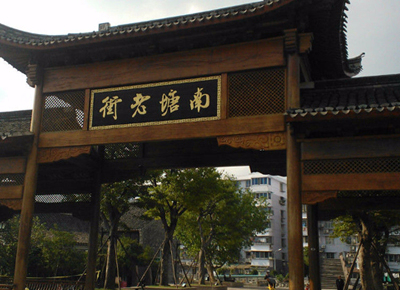
Nantang River Historical and Cultural Block
The block borders the Nantang River on the west, the Yinjiang’an Road on the north, a planned road on the east and the Zuguanshan Road on the south, covering an area of 7.08 hectares in total. The descendants of famous Song scholar Yuan Xie have resided here for generations. Moreover, in the place is a cultural site under district protection—the Yongshui Bridge—and cultural sites under municipal protection including Yuan’s old building cluster, the old residence of Yuan Muzhi, Yu’s Ancestral Temple, the Yongshan Pavilion, the Guansheng Hall and the Tongmao Workshop The water town landscape and the streetside residences and shops form the unique sight of the block. It’s now called “Nantang Old Street”, consisting of two parts—the North Street and the South Street. The North Street is based on traditional culture, focuses on business and aims at the development of urban tourism. The South Street pursues “urban entertainment”, advocating easy life.
Xiushui Street Historical and Cultural Block
First taking shape in the Song Dynasty, it is one of the two best-preserved cultural blocks in the old city of Ningbo. In the block, there are many traditional residential buildings including the May Flower Hall of the Ming Dynasty, Wu’s Residence and Sun’s Residence of the Ming and Qing Dynasties, Lin’s Residence, Chen’s Residence, Xu’s Residence and Henianfang of the Republican period. On the whole, it’s a traditional residential block in Ningbo during the Ming, Qing and Republican Period. In the future, through a specially designed approach, the place will reassume its role as a residential block, evolving into a live museum without walls.
Fufu Shi &Yongshou Street Historical and Cultural Block
With the Yongshou Street as the axis, the block reaches the Xiaowen Street in the north, the Wenchang Street in the west, the Xihe Street in the north, and a planned road south of Yongshou Street in the south, including the Wan’s Residence and the Tu’s Residence. The block gathered the first crop of libraries, official buildings and residences of the Ming and Qing Dynasties such as Fufu Shi, Tu’s library, Wan’s Residence and Yuanrong Mansion. It also has preserved the original appearance of the roads, the architecture and the high walls along deep lanes; it’s a traditional block in very typical Ming and Qing styles in the Ningbo city.
